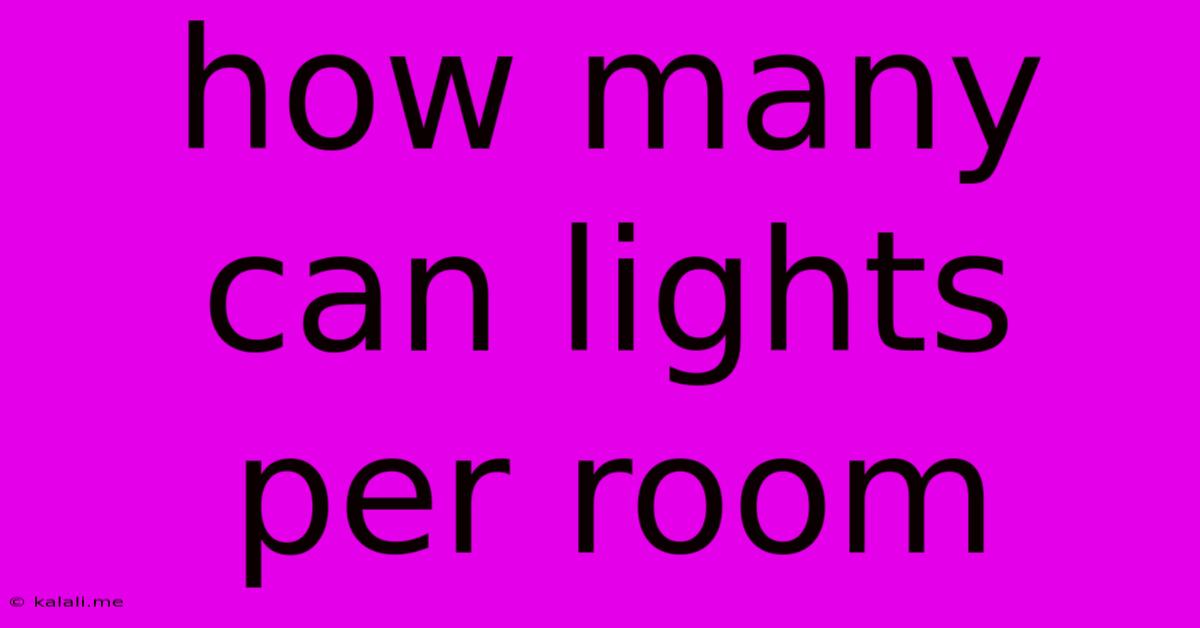How Many Can Lights Per Room
Kalali
Jun 03, 2025 · 4 min read

Table of Contents
How Many Can Lights Per Room? A Guide to Perfect Illumination
Choosing the right number of can lights for a room can feel overwhelming. Too few, and your space will be dimly lit and uninviting. Too many, and you'll have harsh, glaring light and potentially a hefty electricity bill. This guide will help you determine the ideal number of can lights for your specific room, balancing aesthetics and functionality. We'll cover factors like room size, ceiling height, intended use, and light fixture choices.
Understanding the Factors that Influence Can Light Placement
Several factors interplay to determine the optimal number of can lights. Let's break them down:
1. Room Size and Shape: The Foundation of Your Lighting Plan
The most crucial factor is the room's square footage. Larger rooms naturally require more lighting fixtures to achieve even illumination. Consider the room's shape too—long, narrow rooms may benefit from a linear arrangement of can lights, while square rooms might necessitate a more evenly spaced grid.
- Small Rooms (under 100 sq ft): Often, 2-3 can lights suffice.
- Medium Rooms (100-200 sq ft): Aim for 3-5 can lights.
- Large Rooms (over 200 sq ft): You'll likely need 5 or more, possibly significantly more depending on the layout and ceiling height.
2. Ceiling Height: Impacting Light Distribution
High ceilings require more can lights to adequately illuminate the space. The light from a single fixture will spread further in a room with low ceilings compared to a high-ceilinged room.
- Low Ceilings (under 8 feet): Fewer can lights might be sufficient.
- Standard Ceilings (8-9 feet): Use the room size guidelines above as a starting point.
- High Ceilings (over 9 feet): You'll likely need more can lights than for rooms with standard ceilings.
3. Intended Use: Matching Lighting to Activities
The purpose of the room significantly influences your lighting needs.
- Living Room: Aim for a balance of ambient and task lighting. Multiple can lights strategically placed can provide general illumination, supplemented by other light sources like table lamps or floor lamps.
- Kitchen: Kitchens require brighter, more focused lighting, particularly above counters and work areas. Consider incorporating under-cabinet lighting in addition to recessed can lights.
- Bedroom: A softer, more relaxed ambiance is usually preferred. Dimmable can lights paired with bedside lamps create a versatile lighting scheme.
- Bathroom: Bathrooms need bright, even lighting for safety and practicality. Combine can lights with a vanity light for optimal illumination.
4. Light Fixture Lumen Output: Brightness and Efficiency
The brightness of your can lights, measured in lumens, impacts the number you'll need. Higher-lumen fixtures can illuminate a larger area, potentially reducing the overall number of lights required. Consider energy-efficient LED options for both cost savings and environmental responsibility.
5. Light Color Temperature: Setting the Mood
The color temperature of your can lights, measured in Kelvin (K), affects the ambiance of the room. Warmer temperatures (2700K-3000K) create a cozy feel, while cooler temperatures (5000K-6500K) provide brighter, more energetic lighting. Consider the room's function when selecting the color temperature.
Calculating the Number of Can Lights: A Practical Approach
While there's no magic formula, a general rule of thumb is to allow approximately 1-1.5 watts per square foot. This is a starting point, and you may need to adjust based on the factors mentioned above. Remember to consider the lumen output of your chosen fixtures and choose dimmable options for greater control. Accurate calculations require detailed room dimensions and fixture specifications.
Beyond the Numbers: Achieving Balanced Illumination
Don't solely focus on the quantity of can lights. Consider the placement and arrangement to ensure even illumination throughout the room. Avoid placing lights directly overhead in a single cluster; instead, distribute them strategically to minimize shadows and glare. Supplementing can lights with other lighting sources such as floor lamps, table lamps, and wall sconces creates a more layered and inviting atmosphere. Professional lighting design consultation might be valuable for complex spaces or specific lighting requirements.
By carefully considering room size, ceiling height, intended use, and light fixture specifications, you can determine the optimal number of can lights to create a well-lit and aesthetically pleasing space. Remember, this is a guideline, and professional consultation is always an option for more complex projects.
Latest Posts
Latest Posts
-
Does Return By Date Include That Day
Jun 05, 2025
-
Main Hvac Duct Gettig Condensation Outside
Jun 05, 2025
-
What Time To Feed Outside Stray Cats
Jun 05, 2025
-
Can I Import A List To Amazon Wishlist
Jun 05, 2025
-
How To Know If Your Fish Is Pregnant
Jun 05, 2025
Related Post
Thank you for visiting our website which covers about How Many Can Lights Per Room . We hope the information provided has been useful to you. Feel free to contact us if you have any questions or need further assistance. See you next time and don't miss to bookmark.